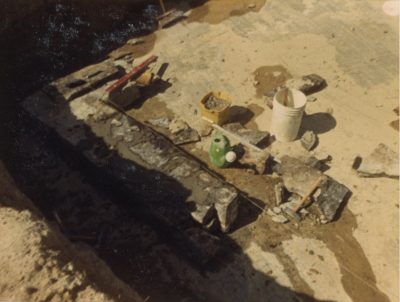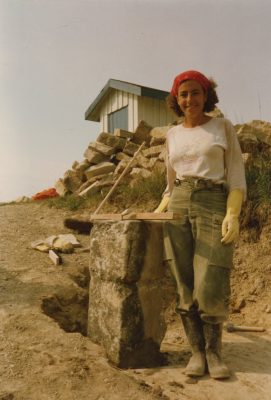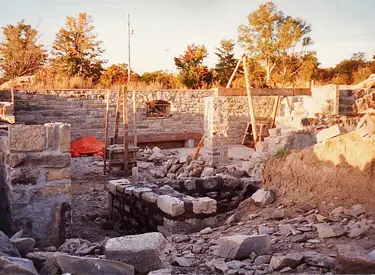This is chapter 13 in my book The Bailey Line Road Chronicles, the 30+ year story about moving from the city to live a modern homestead life deep in the country on Manitoulin Island, Canada. Missed Chapter 12? Click here to read it.
Want to start from the beginning? Click here for Chapter 1.
************************
 I laid the first stones of our basement in July 1986. Basement walls are 24” thick, about 8-feet high, and a total of 146 feet of total wall length. The whole stone basement thing ended up being our main working focus for three seasons a year for a total of about 2500 working hours until the basement was complete in July 1989. That’s when I began framing the house (more on this later), a job I completed that same building season, from July to the end of October. The funny thing is, looking back now, I realize that there were three big mistakes I didn’t know I was making at the time. Perhaps what I now recognize about these mistakes can help you in your life.
I laid the first stones of our basement in July 1986. Basement walls are 24” thick, about 8-feet high, and a total of 146 feet of total wall length. The whole stone basement thing ended up being our main working focus for three seasons a year for a total of about 2500 working hours until the basement was complete in July 1989. That’s when I began framing the house (more on this later), a job I completed that same building season, from July to the end of October. The funny thing is, looking back now, I realize that there were three big mistakes I didn’t know I was making at the time. Perhaps what I now recognize about these mistakes can help you in your life.
Mistake#1: Being Too Careful
As a brand new, self-educating stone mason apprentice, I was much too careful about how I worked. That was a product of my uncertainty, yes, but it’s also a product of the fact that my default approach in life is to be too careful. The first day with the trowel resulted in just six stones being laid. If I did the same work today I could get it done in less than an hour, not ten hours. Granted, these first stones were laid very well, and I was completely happy with them, but still. More than one hour per stone was way too much time. How did I even spend that much time on it? I’m not sure.
I remember Ivan, my old-time neighbour, came over at the end of that first stoneworking day and gave a little chuckle. I didn’t understand it at the time, but now I see. I’m sure he was amused at how long it took me to do such a small amount of work. I had roughly 200 tons more stone to shape and lay before the basement was complete. Thankfully I didn’t have any idea what “200 tons” meant at the time.

Lesson Learned: When it comes to the practicalities of life (such as building a stone basement), It’s not enough to be good at the job. You also need to be fast. I now know that combining the virtues of speed and quality is where success is really found. Perfectionism and its slow pace is the enemy of progress.
Mistake#2: Thinking Badly
 The second mistake I made was thinking too far into the future. Thinking is a necessary activity, of course, but thinking can also be the most debilitating thing you do when the thoughts lead to a sense of overwhelment, discouragement and the idea that you’ve gotten yourself into something way too big. In cases like these, the less you think beyond the moment the better. I didn’t know any of this then, but I do now. Perhaps what I’ve learned about shortening a personal mental timeline can help you, too. I call this strategy the “variable mental timeline” and it really works. Here’s how . . .
The second mistake I made was thinking too far into the future. Thinking is a necessary activity, of course, but thinking can also be the most debilitating thing you do when the thoughts lead to a sense of overwhelment, discouragement and the idea that you’ve gotten yourself into something way too big. In cases like these, the less you think beyond the moment the better. I didn’t know any of this then, but I do now. Perhaps what I’ve learned about shortening a personal mental timeline can help you, too. I call this strategy the “variable mental timeline” and it really works. Here’s how . . .
At any given moment in our lives, we all have more or fewer challenges, demands, expectations and disasters to deal with. Sometimes life is relatively simple and smooth, while other times deadlines and turbulence crowd in. Sometimes life gets overwhelming, and the more often and deeper this happens, the more debilitating the mental side of life becomes. For some people the turmoil in the head and heart degenerates into a destructive spiral. The root of the problem of overwhelment ultimately (usually called “stress” these days) exists only in the imagination and in the imagination is where relief can be found.
While it’s true that there’s usually nothing you can do in the immediate term to get rid of life’s demands, there’s no reason you need to think about those demands all the time. The fact is, the amount of productive “thinking time” required to deal even with large challenges is usually quite small. The rest is destructive “worry time” born in your imagination. That’s why you’ll feel A LOT better if you shorten your mental time scope on purpose. Shorten as much as necessary until you feel better in a given situation. Here’s how I do it . . .
Whenever I find it stressful or overwhelming to think about big, challenging and possibly ugly realities in life, I imagine these things don’t exist until some work or action is required of me. Am I warm and dry right now? Am I fed? Am I clothed? Am I safe right this second? If my answer to all these things is “yes”, then I permit myself to ignore everything else in the universe of possible worries. In fact, I force myself to forget. When you temporarily permit yourself a mental timeline of, say, no more than 3 minutes, it’s a lot easier to remain sane. After that it’s back to ordinary thinking until anxiety and overwhelment appear again.
The technique of shortening one’s mental timeline on purpose really does work. It’s amazing, and it’s what gave me the mental stamina to keep on building that basement with stone. Capable, ambitious, conscientious or self-focussed worry-prone people, in particular, often get over-spun because they think about too much at once. It’s like food. A normal mouthful of roast beef is great, but try eating the whole roast in one gulp and you’ll choke. It’s impossible and it’s the same with life’s challenges. Shorten your time perspective enough to reach a sane balance, dialing in shorter or longer timelines of consciousness until you find a manageable load at any given moment. Sometimes the future doesn’t exist for me past the next ten minutes. Other times, I can think of the entire day without issues. Have you tried to intentionally shorten your time line? It’s one of life’s simple yet powerful mental strategies. It also has an analogy with the world of power tools.
In some ways, your inner self is like a cordless drill. It’ll work fine for a while, but eventually the battery needs to come out and sit idle in the charger for a time. Every moment you think of life’s hard things unnecessarily it prevents your mental “battery” from sitting in the charger and gaining more power. In fact, every moment you sit there and think about something that you’re not currently in a position to change, you’re discharging your mental battery plus getting nothing out of it. It’s a lose-lose situation and probably the #1 root cause of damaging levels of stress.
There’s great stamina in a shortened time line, but you need to cultivate the inner skill to make it happen. Success takes practice because your mind will keep trying to eat the whole roast beef at once. But the more that a shortened timeline helps you, the more you’ll trust it and the less your mind and imagination will try to make your perspective too long. Success takes practice.
The problem with the future is that it has a nasty habit of trying to creep into the present. And future concerns want nothing more than to make you feel like you MUST deal with them all at once, all the time. This is not true. In fact, the reality of life is very different. The more you’re able to forget issues where no immediate action is possible or necessary, the more you’ll be able to accomplish with a light heart.
Want to know a powerful secret I’ve discovered? Shortening my timeline works great, but it would never be enough on its own. That’s why I find it essential to completely unplug every Sunday. It’s like shortening my timeline down to zero for everything I have going on in my working life on that day. I never let myself work or even think about work on Sundays even though I sometimes dearly want to get things done. It’s a mental discipline, and like all disciplines it involves paying a price to get something more valuable in return. In this case, it’s an especially great deal. Just don’t go and do the really foolish thing and convince yourself that you “can’t” take Sunday’s off. So often the word “can’t” actually means “won’t”. We suffer accordingly.
One of the most ancient sources of wisdom advises complete rest every seven days and it’s a golden concept. I didn’t always follow this wisdom, but after working seven days a week until the mid-1990s, I now know I’ll never go back. Do all your work in six days (not five), but the seventh day is for rest.
Isn’t it strange how so much of the world claims to be concerned about diet, exercise and “healthy living” while at the same time ignoring the old boundaries designed to keep work and worry in its place? Could the absence of a true rest day in our society be why we’re seeing an epidemic of debilitating anxiety and depression, especially among young people?
Lesson Learned: Our ability to happily complete things in life (especially big things) is largely based on the way we think. When feelings of overwhelment happen, that’s a sign that you’re thinking about too many things too far into the future. Displace destructive thoughts with constructive ones. Identify specific things in life to be thankful for and displace the debilitating thoughts with positive ones.
Mistake#3: An Addiction to Progress
 Hope and enthusiasm can be devastating things, as I discovered when a little glimmer of hope showed up during construction of the basement. That’s when I discovered an old stone house that had been demolished about 10 miles from my place. The stones were all cut and faced and available for anyone to buy for use as traditional limestone building material. A couple of seasons of struggling with sub-standard stone made it easy for me to love the stones from that old house. Getting stones like these would be good news indeed because the most time consuming part of building with stone so far had been collecting the stones by hand from fields. If I could get a pile of stones delivered by truck to my place, it would certainly speed progress.
Hope and enthusiasm can be devastating things, as I discovered when a little glimmer of hope showed up during construction of the basement. That’s when I discovered an old stone house that had been demolished about 10 miles from my place. The stones were all cut and faced and available for anyone to buy for use as traditional limestone building material. A couple of seasons of struggling with sub-standard stone made it easy for me to love the stones from that old house. Getting stones like these would be good news indeed because the most time consuming part of building with stone so far had been collecting the stones by hand from fields. If I could get a pile of stones delivered by truck to my place, it would certainly speed progress.
It was a week or so before I contacted the owner of the stones and the property they sat on – a man named Lewis Runnalls. Lewis is a farmer, but also one of Manitoulin’s first real estate agents, and a financially shrewd guy. As I’ve explained, official real estate “agents” were a relatively new thing on the Island even in the mid-1980s. Back then a lot of property simply sold from one owner to the next. Lewis was actually one of the first ever real estate agents on Manitoulin and he had shown us the property we almost bought when we were looking in August 1985. I didn’t know Lewis very well when I called him up to see about a price for the stone, but I had a feeling he would drive a hard bargain.
“$3500 is what I’ll take”, explained Lewis on the phone. “ You’d have to pay a lot more than that if you hired a mason to quarry and dress all those stones.” Lewis was right, of course, the value was there compared with hiring a stone mason to help. What wasn’t there was enough money in my bank account. I had expected something much more reasonably priced, like the few dollars I paid previously for the old wood I built my outhouse from. The moment I realized that my hope was going to cost more than I could afford, that’s when dark discouragement descended on Mary and I. A week’s worth of longing to have those stones laid the emotional groundwork for some major disappointment. That’s what I was experiencing. When Lewis said “$3500” on the phone, day turned to night inside my chest. Looking back, I’m surprised at how hard this hit me at the time. I now know to be more careful in the first place when it comes to ideas of hope and progress. Hope looks innocent enough at first, but it’s not. As necessary, useful and empowering a thing as hope and progress can be, no one ever talks about the downside of hope and the dangers it poses.
Lesson Learned: Euphoric enthusiasm about a project might be an enjoyable emotion at the time, but it’s also the flip side of the same coin that brings discouragement when things don’t go well. The higher you allow yourself to fly emotionally when times are fortunate and the prospects for progress look terrific, the farther you’ll fall when the cause of that hope is dashed. Better just to plow ahead with life’s work and challenges. Don’t let yourself get too happy while things are unfolding and you’ll probably maintain enough enthusiasm to keep on going until completion. Too much hope and relief today can lead to big trouble tomorrow. There’s a lot to be said for remaining emotionally even tempered.
Lessons Learned While Building the Basement
It’s interesting how a human life takes on different tones at different stages. Once Mary and I settled into the rhythm of building the basement out of stone, life was simple and satisfying. We usually went three weeks without leaving the property to go into town for supplies, and that suited us fine. Actually, I’m much more of a hermit than Mary, so it probably suited me better than her.
All this isn’t to say that Mary and I always worked together in harmony. I was alone on the land for the actual building of the outhouse that I told you about earlier, but we worked together for hundreds of hours on the stonework of the basement that came later. And if you’ve ever built anything big, you know there needs to be a hierarchy of personnel in the process. Someone has to be quarterback, others have to follow. The thing is, the era we live in today inclines many women to resist taking directions from a man (unless it’s her boss), and perhaps especially from her husband. I had at least some building experience by this time, so that put me in the position of deciding what needed to be done and how, and this posed some of its own “diplomatic” challenges.

Over the time it took us to get our house to a state we could live in, there was sometimes friction. Cold, wet and tired, I might lapse into a quick, jobsite-type command without thinking about it: “Move the end of that plank over so I can get it lined up.” Please and thank you takes more effort than just barking, so it usually gets omitted in the triage that sets in under fatigue and rapid work pace at real construction sites. This doesn’t indicate impatience, but it sounds like it does. If you’ve ever worked on a construction site professionally, you’ll know that efficiency often trumps polite pleasantries. That’s just the way it is and no one expects to be emotionally uplifted when they’re building a house, an apartment tower or a highway. No one gives or receives “please”, “thank you”, and “you’re welcome” on these crews. The focus is to get the job done as efficiently as possible. Unfortunately, Mary had never worked on a commercial construction site before.
Offended, tired, dirty and not feeling particularly cherished, Mary might kick into offended mode after a few verbal missteps on my part. There are two signs of offended mode with her. Perhaps you know them. First, there’s an almost complete lack of unnecessary talking. Verbal communication pulls back to the bare necessities. Perhaps even less. When Mary got to the point where she wouldn’t make eye contact with me, then I knew there was trouble. I still know that to be a sign.
Looking back on it now, I think we probably worked as well as we could together given what we had to deal with. Newly married and with an uncertain future, no running water, no house and no appliances, there were two things that I believed kept the show on the road for us. First, we were married, and this means commitment, at least for us. More than 100+ people had witnessed us pledge submission and selflessness to each other on June 4, 1988, 100+ people and God. I once saw a study that showed how the stability of marriage is related to the size of the wedding. Yes, apparently large weddings translate directly into more stable marriages. There are other factors involved, of course, but perhaps big weddings help keep married people together because they harness the power of public commitment and not wanting to disappoint people. Are these great emotions on which to build a marriage? No, not fundamentally, but they clearly do serve a purpose. I’ve found married bliss or lack thereof moves in cycles. Dark times never last, nor do happy times. Having a stable marriage is a great thing, and if an emotion like embarrassment or not wanting to disappoint parents relatives and friends can keep you in a marriage until the sun rises again, then that’s okay in my book. One thing is for sure . . . the biggest lie foisted on the world by Hollywood is the idea that some people were “meant for each other”, and some people are not. That’s nothing more than dangerous nonsense and it’s why the majority of children do not grow up with two biological parents in the home.
Another thing that kept us together was the fact that we shared a common goal. The house, the land, our plans for a family – we have always been of one mind on these big issues. So today, 30+ years after Mary and I wallowed in the basement hole wrestling with stone, mortar and wood, I often find myself remembering how we laid the groundwork for the floor that holds up our kitchen table surrounded by kids and grandkids that now exist as realities, realities that we could only imagine back when the basement was a muddy hole in the ground. Whenever we sit down to a family feast or a little snack for just Mary and I, I’m reminded of the extra depth of enjoyment I feel because we made our homestead house from the ground up with our own hands. This sort of thing might not matter much to some people, but it certainly matters to us.
As I’ve mentioned before, Mary had no experience building anything before we started our Manitoulin adventure. She’d never even been camping, never lived without hot and cold running water on tap, and never lived with out a clothes closet, eating the bare minimum of food and enjoying the bare minimum of comforts. We lived in that breezy 10-foot x 20-foot shed I told you about, and despite these challenges, Mary got very good at her construction specialties. One of these was mixing mortar. She got to the point where she could reliably mix a wheelbarrow load of perfect mortar every time, then roll that full wheelbarrow to the building site, then down the soil ramp that led into the basement space. Mary even got to the point where she’d show off and halt the progress of a wheelbarrow load of mortar as she’d travel down that ramp onto the basement floor.
Lessons from Stone Arches
 Until part way up the basement walls, the most complicated part of the basement construction work was the corners. The inside face of each of the four corners needed to be plumb (straight up and down), and the outside of each corner plumb, too. A four foot level is the tool of choice for this. You hold the level up plumb, then bring the corner stone that you’re setting down right up the level, but not beyond. Building corners seemed like a big deal before I got going, but accuracy was easy with practice. The arches over each basement window opening proved more challenging, especially since I hadn’t yet figured out how to shape stones quickly and easily.
Until part way up the basement walls, the most complicated part of the basement construction work was the corners. The inside face of each of the four corners needed to be plumb (straight up and down), and the outside of each corner plumb, too. A four foot level is the tool of choice for this. You hold the level up plumb, then bring the corner stone that you’re setting down right up the level, but not beyond. Building corners seemed like a big deal before I got going, but accuracy was easy with practice. The arches over each basement window opening proved more challenging, especially since I hadn’t yet figured out how to shape stones quickly and easily.
My plan was to build two basement windows, each leading into a stone window well. The idea with the arch is to eliminate any steel reinforcement that would otherwise hold up the stones. Steel reinforcement is sometimes used because ordinary masonry alone can’t span much of a gap. And while an arch is entirely masonry, it does the job of spanning without steel because every stone wants to fall at the same time. They can’t do that, hence the stones stay up. An arch also converts the downwards force of gravity working on all those stones into outward force horizontally on each side of the arch. As long as enough stonework exists beyond the sides of the opening, the arch stones cannot fall down. The trick is shaping stones precisely, then holding them up with a wooden form while the mortar hardened.
Building a wooden arch form is fairly easy. The form needs to be as wide as the window opening, with an upward curve on the top surface that the stones rest on in an arch shape. Legs underneath the form hold it up to the correct level. Cutting the stones was a bigger issue because I didn’t have any power tools at the time. So far I’d just shaped the stones with the hand tools I’ve told you about, but that wasn’t going to work in this case. More on this in future chapters.

In September 1989 Mary was back in Toronto completing her nursing training while I was still on Manitoulin working to get the roof shingled and dry for winter. It was an intense time made more intense by a phone call I got from Mary. The only option for us at the time was a dial-up phone line that was also a party line. This means that up to four houses would have telephones that functioned essentially as extensions. We all heard the phone ring no matter who was getting the call, and anyone could listen in on our conversations if they were nosy enough. An elderly lady named Verna lived along BaileyLineRoad, and she had no hesitancy picking up the phone and listening in on our conversations. You could her the telltale “click” of the receiver being lifted, then the creak-creak of her rocking chair. If Verna had a cold or congestion, you could hear breathing, too.
I can’t remember if Verna as listening in to this particular call, but it would have been worth her while. Mary was calling to tell me she was pregnant. This was not planned and raised a bunch of big questions. What would it do to our plans with a baby on the scene? We had no house and no regular income. We had a ton of work ahead of us, too.
All this certainly made me have to pull back on my mental timeline. The stress potential was high, but Mary and I both believe that human life is sacred and begins at the moment of conception. Children are special and worth more than our particular plans for the future. We would do whatever it took to accommodate this new little person in our lives.
I’d spent a month getting used to the idea of being a dad, when I got another call from the city. It was Mary’s mother this time. She was calling to tell me that Mary had just had a miscarriage. Mary was still in the hospital. The last night before I’d planned to travel down to the city to see Mary, I had a vivid dream. It was more real than most dreams and it was short, with no words just images. In this dream there was a little girl. She was about 3 years old, she had vibrant blond hair and she was laughing for joy as she moved away from me. Her laughs were deep and authentic and they didn’t stop until she had completely disappeared from my sight in the dream. Maybe this dream was a result of everything that had been going on in my life up until then, but my impression is that it was more than just a nocturnal creation of my mind. Someday I expect to know for sure.
Chapter 14 coming up . . . In the next chapter I’ll explain how a very fortunate event happened in the summer of 1989, shortly after I began framing the house, and it arrived at exactly the right moment.
 Want to be a key part of making The Bailey Line Road Chronicles a published book? I’m looking for a few good patrons to partner with me to complete this project. Just a couple of dollars a month gets you your own printed copy of the book when it’s done. Click here to find out more.
Want to be a key part of making The Bailey Line Road Chronicles a published book? I’m looking for a few good patrons to partner with me to complete this project. Just a couple of dollars a month gets you your own printed copy of the book when it’s done. Click here to find out more.


